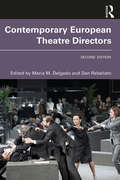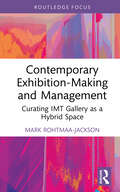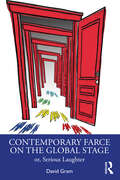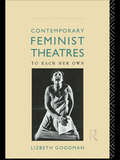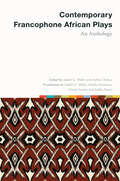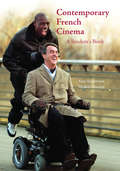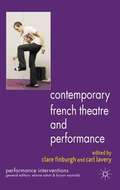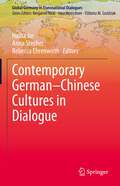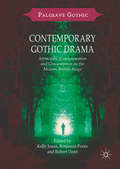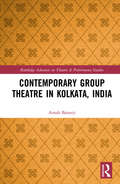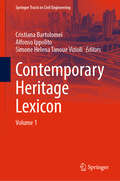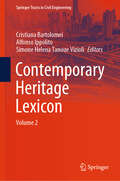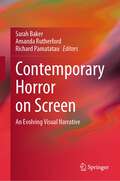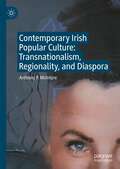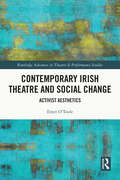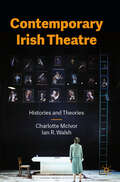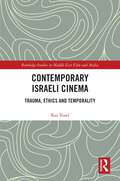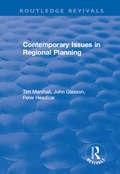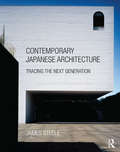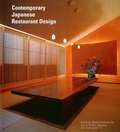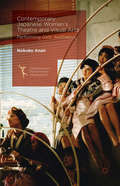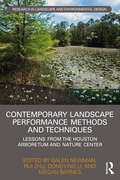- Table View
- List View
Contemporary European Theatre Directors
by Maria M. Edited by DelgadoThis expanded second edition of Contemporary European Theatre Directors is an ambitious and unprecedented overview of many of the key directors working in European theatre over the past 30 years. This book is a vivid account of the vast range of work undertaken in European theatre during the last three decades, situated lucidly in its artistic, cultural, and political context. Each chapter discusses a particular director, showing the influences on their work, how it has developed over time, its reception, and the complex relation it has with its social and cultural context. The volume includes directors living and working in Italy, Germany, France, Spain, Poland, Russia, Romania, the UK, Belgium, Switzerland, and the Netherlands, offering a broad and international picture of the directing landscape. Now revised and updated, Contemporary European Theatre Directors is an ideal text for both undergraduate and postgraduate directing students, as well as those researching contemporary theatre practices, providing a detailed guide to the generation of directors whose careers were forged and tempered in the changing Europe following the end of the Cold War.
Contemporary Exhibition-Making and Management: Curating IMT Gallery as a Hybrid Space (Routledge Focus on the Global Creative Economy)
by Mark Rohtmaa-JacksonThis book provides a unique insight into contemporary curation and management in an innovative London-based gallery. Using a critical in-depth case study exploration of IMT art gallery’s ‘successes’ and ‘failures’, it illustrates and evaluates contemporary issues and challenges in curatorial initiatives and exhibition-making strategies. IMT operates as a ‘hybrid space’, combining characteristics of both the commercial gallery sector with non-profit artist-led or garage spaces while retaining affiliations to academic teaching and research. This book explores its structure, behaviour, history, partnerships and exhibition programme through a variety of disciplinary lenses, bringing together cultural, creative, economic, and pedagogical perspectives, as well as the effect of recent sociocultural impacts of the global financial crisis, and the COVID-19 pandemic. Research-based and thought-provoking, this study will be of great interest to researchers, advanced students and professionals in curatorial studies, museum and gallery management, and art markets.
Contemporary Farce on the Global Stage: or, Serious Laughter
by David GramContemporary Farce on the Global Stage provides audiences and practitioners a detailed survey of how the genre of farce has evolved in the 21st century. Often dismissed as frivolous, farce speaks a universal language, with the power to incisively interrogate our world through laughter.Unlike farces of the past, where a successful resolution was a given and we could laugh uproariously at adulterous behaviour, farce no longer guarantees an audience a happy ending where everything works out. Contemporary farce is no longer ‘diverting us’ with laughter. It is reflecting the fractured world around us. With a foreword by award-winning playwright Ken Ludwig, the book introduces readers to the Mechanics of Farce, and the ‘Four Ps,’ which are key elements for understanding, appreciating, and exploring the form. The Five Doors to Contemporary Farce identify five major categories into which farces fall. Behind each door are a wide selection of plays, modern and contemporary examples from all over the world, written by a diverse group of playwrights who traverse gender, race, ethnicity, and sexual orientation. Supplementing each section are comments, observations, and reflections from award-winning playwrights, directors, actors, designers, dramaturgs, and scholars.Designed specifically to give theatre-makers a rounded understanding that will underpin their own productions, this book will also be of use to theatre and performance studies students.
Contemporary Feminist Theatres: To Each Her Own (Gender in Performance)
by Lizbeth GoodmanContemporary Feminist Theatres is a major evaluation of the forms feminism has taken in the theatre since 1968. Lizbeth Goodman provides a provocative and interdisciplinary study of the development of feminist theatres in Britain. She examines the treatment of key issues such as gender, race, sexuality, language and power in performance. Based on original research and fresh data, Contemporary Feminst Theatres is a fully comprehensive and admirably clear analysis of a flourishing field of practice and inquiry.
Contemporary Francophone African Plays: An Anthology (Scènes francophones: Studies in French and Francophone Theater)
by Edited by Judith G. MillerBringing together in English translation eleven Francophone African plays dating from 1970 to 2021, this essential collection includes satirical portraits of colonizers and their collaborators (Bernard Dadié’s Béatrice du Congo; Sony Labou Tansi’s I, Undersigned, Cardiac Case; Sénouvo Agbota Zinsou’s We’re Just Playing) alongside contemporary works questioning diasporic identity and cultural connections (Koffi Kwahulé’s SAMO: A Tribute to Basquiat and Penda Diouf’s Tracks, Trails, and Traces…). The anthology memorializes the Rwandan genocide (Yolande Mukagasana’s testimony from Rwanda 94), questions the status of women in entrenched patriarchy (Werewere Liking’s Singuè Mura: Given That a Woman…), and follows the life of Elizabeth Nietzsche, who perverted her brother’s thought to colonize Paraguay (José Pliya’s The Sister of Zarathustra). Gustave Akakpo’s The True Story of Little Red Riding Hood and Kossi Efoui’s The Conference of the Dogs offer parables about what makes life livable, while Kangni Alem’s The Landing shows the dangers of believing in a better life, through migration, outside of Africa.
Contemporary French Cinema: A Student's Book
by Alan J. Singerman Michèle BissièreLike its French-language companion volume Le Cinéma français contemporain: Manuel de classe, Alan Singerman and Michèle Bissière's Contemporary French Cinema: A Student's Book offers a detailed look at recent French cinema through its analyses of twenty notable and representative French films that have appeared since 1980. Sure to delight Anglophone fans of French film, it can be used with equal success in English-language courses and, when paired with its companion volume, dual-language ones.Acclaim for Le Cinéma français contemporain: Manuel de classe "From Le Dernier Métro to Intouchables, Bissière and Singerman cover the latest trends of French cinema, emphasizing context and analytical method as Singerman did in Apprentissage du cinéma français (Focus 2004). The authors offer a selection of films most French cinephiles will applaud, and they incorporate insights from some of the best critical work on French cinema. Students of French film will also find all the bibliographical pointers they need to dig deeper, and instructors will appreciate the pedagogical components included in the chapters." —Jonathan Walsh, Department of French Studies, Wheaton College, Massachusetts "This remarkable book comes to us from two seasoned teachers and critics and beautifully complements an earlier work, Alan Singerman's Apprentissage du cinéma français. The time period covered, more targeted here than in the preceding text, is admirably well chosen, and the breakdown by broad category, each offering multiple options, guides the teacher while offering a choice among an abundance of interesting films. The preliminary chapters, both succinct and informative, give students an excellent overview of French cinema as a whole and of the technical knowledge needed for film analysis. Each of the subsequent chapters offers an indispensable introduction discussing the plot, director, production, actors, reception, and context of the film in question and also provides a very useful filmography and bibliography… an exemplary work." —Brigitte E. Humbert, Department of French and Francophone Studies, Middlebury College
Contemporary French Theatre and Performance
by Clare Finburgh Carl LaveryThis is the first book to explore the relationship between experimental theatre and performance making in France. Reflecting the recent return to aesthetics and politics in French theory, it focuses on how a variety of theatre and performance practitioners use their art work to contest reality as it is currently configured in France.
Contemporary Furniture: 17 Projects You Can Build
by Editors of Popular WoodworkingMatching furniture to your home decor can be a tall order. Classic furniture styles with intricate details can overpower a room or clash with other styles in the typical home. That's one of the reasons why contemporary furniture is so popular - and why woodworkers love to build it.Contemporary furniture has an understated elegance that is suited to just about any room, regardless of decorating style. This book presents 17 contemporary furniture projects hand-picked from the pages of Popular Woodworking Magazine and American Woodworker magazine. Each one comes with step-by-step instructions, high-quality diagrams, cutting lists, color photos and detailed, easy-to-follow assembly techniques. Inside you'll find:Elegant side tablesAn open-construction bookcaseSleek modern cabinetsA mid-century inspired coffee tableA city sideboardAnd other stylish projectsFrom simple drawer pulls to gracefully beveled edges, contemporary furniture offers a subtle elegance that can really bring the room together. Let this book be your guide, and create your own contemporary pieces today.
Contemporary German–Chinese Cultures in Dialogue (Global Germany in Transnational Dialogues)
by Haina Jin Anna Stecher Rebecca EhrenwirthThis book provides a unique perspective on contemporary German and Chinese cultural encounters. Moving away from highlighting exchanges between the two countries in terms of colonial connections, religious influences and philosophical impacts, the book instead focuses on the vast array of modern cultural dialogues that have influenced both countries, especially in literature, theatre and film. The book discusses issues of translation, adaptation, and reception to reveal a unique cultural relationship. The editors and contributors examine the existing programs and strategies for cultural interchange, and analyse how these shape or have shaped intercultural dialogue, and what kind of intercultural exchange is encouraged. This book is of interest to students and researchers of film and media studies, Sinophone studies, transnational studies, cultural studies and social and cultural anthropology.
Contemporary Gothic Drama: Attraction, Consummation and Consumption on the Modern British Stage (Palgrave Gothic)
by Kelly Jones Robert Dean Benjamin PooreThis ground-breaking volume is the first of its kind to examine the extraordinary prevalence and appeal of the Gothic in contemporary British theatre and performance. Chapters range from considerations of the Gothic in musical theatre and literary adaptation, to explorations of the Gothic’s power to haunt contemporary playwriting, macabre tourism and site-specific performance. By taking familiar Gothic motifs, such as the Gothic body, the monster and Gothic theatricality, and bringing them to a new contemporary stage, this collection provides a fresh and comprehensive take on a popular genre. Whilst the focus of the collection falls upon Gothic drama, the contents of the book will embrace an interdisciplinary appeal to scholars and students in the fields of theatre studies, literature studies, tourism studies, adaptation studies, cultural studies, and history.
Contemporary Group Theatre in Kolkata, India (Routledge Advances in Theatre & Performance Studies)
by Arnab BanerjiThis book is the first of its kind offering a materialistic semiotic analysis of a non-Western theatre culture: Bengali group theatre. Arnab Banerji fills two lacunas in contemporary theatre scholarship. First, the materialist semiotic approach to studying a non-Western theatre event allows Banerji to critically examine the material conditions in which theatre is created and seen outside the Euro-American context. And second, by shifting the critical lens onto a contemporary urban theatre phenomenon from India, the book attempts to even out the scholastic imbalance in Indian theatre scholarship which has largely focused on folk and classical traditions. The book shows a refreshing new perspective toward a theatre culture that frequently escapes the critical lens in spite of being one of the largest urban theatre cultures in the world. Theatre events are a sum total of the conditions in which they are built and the conditions in which they are viewed. Studying the event separate from its materialistic beginnings and semiotic effects allow only a partial insight into the performance phenomenon. The materialist semiotic critical framework of this book locates the Bengali group theatre within its performative context and offers a heretofore unexplored insight into this vibrant theatre culture.
Contemporary Heritage Lexicon: Volume 1 (Springer Tracts in Civil Engineering)
by Cristiana Bartolomei Alfonso Ippolito Simone Helena Tanoue VizioliThis book presents themes related to contemporary architecture as the results of diverse cultural influences and architectural legacies, manifested in a rich variety of styles, materials, and spatial perceptions. It consists of 24 chapters written by authors from various continents and contains the result of research highlighting contemporary architecture in relation to multiple aspects that are distinguished by their eclectic nature, characterized by the integration of diverse cultural and architectural influences. The book examines aspects involving material aspects, technologies, design, history, salvage, technologies, and digitization. The aspects covered are always filtered through research, which objectively integrates traditional and innovative approaches. Thus, the focus is to explore the contemporary lexicon not only in the field of architecture and engineering, but in all those areas where this theme can be read with a meaningful vision. Contemporary architecture is constantly evolving, reflecting the changing needs of society and anticipating the challenges of the future.
Contemporary Heritage Lexicon: Volume 2 (Springer Tracts in Civil Engineering)
by Cristiana Bartolomei Alfonso Ippolito Simone Helena Tanoue VizioliThe book presents themes related to contemporary architecture as the results of diverse cultural influences and architectural legacies, manifested in a rich variety of styles, materials, and spatial perceptions. It consists of 24 chapters written by authors from various continents and contains the result of research highlighting contemporary architecture in relation to multiple aspects that are distinguished by their eclectic nature, characterized by the integration of diverse cultural and architectural influences. The book examines aspects involving material aspects, technologies, design, history, salvage, technologies, and digitization. The aspects covered are always filtered through research, which objectively integrates traditional and innovative approaches. Thus, the focus is to explore the contemporary lexicon not only in the field of architecture and engineering but in all those areas where this theme can be read with a meaningful vision. Contemporary architecture is constantly evolving, reflecting the changing needs of society and anticipating the challenges of the future.
Contemporary Horror on Screen: An Evolving Visual Narrative
by Amanda Rutherford Sarah Baker Richard PamatatauThis book highlights how horror in film and television creates platforms to address distinct areas of modern-day concern. In examining the prevalence of dark tropes in contemporary horror films such as Get Out, Annabelle: Creation, A Quiet Place, Hereditary and The Nun, as well as series such as Stranger Things, American Horror Story and Game of Thrones, amongst numerous others, the authors contend that we are witnessing the emergence of a ‘horror renaissance’. They posit that horror films or programmes, once widely considered to be a low form of popular culture entertainment, can contain deeper meanings or subtext and are increasingly covering serious subject matter. This book thus explores how horror is utilised as a tool to explore social and political anxieties of the cultural moment and is thus presented as a site for contestation, exploration and expansion to discuss present-day fears. It demonstrates how contemporary horror reflects the horror of modern-day life, be it political, biological, social or environmental. A vital contribution to studies of the horror genre in contemporary culture, and the effect it has on social anxieties in a threatening and seemingly apocalyptic time for the world, this is a vital text for students and researchers in popular culture, film, television and media studies.
Contemporary Irish Popular Culture: Transnationalism, Regionality, and Diaspora
by Anthony P. McIntyreThis book uses popular culture to highlight the intersections and interplay between ideologies, technological advancement and mobilities as they shape contemporary Irish identities. Marshalling case studies drawn from a wide spectrum of popular culture, including the mediated construction of prominent sporting figures, Troubles-set sitcom Derry Girls, and poignant drama feature Philomena, Anthony P. McIntyre offers a wide-ranging discussion of contemporary Irishness, tracing its entanglement with notions of mobility, regionality and identity. The book will appeal to students and scholars of Irish studies, cultural studies, as well as film and media studies.
Contemporary Irish Theatre and Social Change: Activist Aesthetics (Routledge Advances in Theatre & Performance Studies)
by Emer O'TooleThis book uses the social transformation that has taken place in Ireland from the decriminalisation of homosexuality in 1993 to the repeal of the 8th amendment in 2018 as backdrop to examine relationships between activism and contemporary Irish theatre and performance. It studies art explicitly intended to create social and political change for marginalised constituencies. It asks what happens to theatre aesthetics when artists’ aims are political and argues that activist commitments can create new modes of beauty, meaning, and affect. Categories of race, class, sexuality, and gender frame chapters, provide social context, and identify activist artists’ social targets. This book provides in depth analysis of: Arambe – Ireland’s first African theatre company; THEATREclub – an experimental collective with issues of class at its heart; The International Dublin Gay Theatre Festival; and feminist artists working to Repeal the 8th amendment. It highlights the aesthetic strategies that emerge when artists set their sights on justice. Aesthetic debates, both historical and contemporary, are laid out from first principles, inviting readers to situate themselves – whether as artists, activists, or scholars – in the delicious tension between art and life. This book will be a vital guide to students and scholars interested in theatre and performance studies, gender studies, Irish history, and activism.
Contemporary Irish Theatre: Histories and Theories
by Ian R. Walsh Charlotte McIvorThis open access book is a new survey of theatre practices in Ireland from 1957 to the present. Part I: Histories, situates the theatrical activity of twentieth and twenty-first century Ireland within its social and political contexts, identifies key practitioners, landmark productions, institutions, festivals, and seminal revivals. Part II: Theories, offers five key theoretical frameworks - nation, language, body, space and interculturalism - to examine contemporary Irish theatre practices. Contemporary Irish Theatre and Performance ultimately offers a more extensive story of contemporary Irish theatre documenting the diversity of practices and contributors that have populated the contemporary Irish theatre landscape since 1957.
Contemporary Israeli Cinema: Trauma, Ethics and Temporality (Routledge Studies in Middle East Film and Media)
by Raz YosefThrough analysis of the complex discourse surrounding trauma and loss, this book provides a necessary examination of temporality and ethics in Israeli film and television since the turn of the millennium. The author examines posttraumatic idioms of fragmentation and incoherence, highlighting the rising resistance towards generic categories, and the turn to unconventional and paradoxical structures with unique aesthetics. Maintaining that contemporary Israeli cinema has undergone an ethical shift, the author examines the revealing traumas and denied identities that also seek alternative ways to confront ethical question of accountability. It discusses the relationships between trauma, nationalism, and cinema through the intertwined perspectives of feminism, queer theory, and critical race and postcolonial studies, showing how national traumas are constructed by notions of gendered, sexual, and racial identity. This innovative text highlights the complexities of discourse surrounding trauma and loss, informed by multiple categories of difference. Across each chapter various elements of Israeli film are explored, spanning from strategies used to critically examine victim-perpetrator dynamics, co-existence in temporal space, women’s cinema in Israel, displacement, and queer communities and identity. Beyond its direct contribution to cinema studies and Israel studies, the book will be of interest to trauma and memory studies, postcolonial studies, gender and sexuality studies, Jewish studies, Middle Eastern studies, and cultural studies.
Contemporary Issues in Regional Planning (Routledge Revivals)
by John GlassonThis title was first published in 2002: Regional planning and government in the UK is undergoing a period of tremendous activity, with a wide range of new policies, innovative techniques and experiments being tested. This volume provides an overview of developments, describing and analyzing the legislative, political and economic contexts within which changes are occurring, and assessing the continuing difficulties that face planners and others operating in the new arrangements for regional planning
Contemporary Japanese Architecture: Tracing the Next Generation
by James SteeleContemporary Japanese Architecturepresents a clear and comprehensive overview of the historical and cultural framework that informs the work of all Japanese architects, as an introduction to an in-depth investigation of the challenges now occupying the contemporary designers who will be the leaders of the next generation. It separates out the young generation of Japanese architects from the crowded, distinguished, multi-generational field they seek to join, and investigates the topics that absorb them, and the critical issues they face within the new economic reality of Japan and a shifting global order. Salient points in the text are illustrated by beautiful, descriptive images provided by the architects and from the extensive collection of the author. By combining illustrations with timelines and graphics to explain complex ideas, the book is accessible to any student seeking to understand contemporary Japanese architecture.
Contemporary Japanese Restaurant Design
by Nacass Partners Motoko Jitsukawa Cornucopia K K.With evocative texts accompanying stunning photographs, Contemporary Japanese Restaurant Design features 28 of the most cutting-edge dining spaces by the country's leading restaurant designers.
Contemporary Japanese Restaurant Design
by Nacass Partners Motoko Jitsukawa Cornucopia K K.With evocative texts accompanying stunning photographs, Contemporary Japanese Restaurant Design features 28 of the most cutting-edge dining spaces by the country's leading restaurant designers.
Contemporary Japanese Women’s Theatre and Visual Arts: Performing Girls’ Aesthetics (Contemporary Performance InterActions)
by Nobuko AnanThis book traces the history of 'girls' aesthetics,' where adult Japanese women create art works about 'girls' that resist motherhood, from the modern to the contemporary period and their manifestation in Japanese women's theatrical and dance performance and visual arts including manga, film, and installation arts.
Contemporary Kogin-zashi: Modern Sashiko Beyond Filling in the Gaps
by Jason Bowlsby Shannon Leigh RoudhanMaster the art of Kogin-zashi stitching Kogin-zashi is an iconic form of sashiko that stands on its own apart from Hitomezashi and Moyouzashi as both functional and breathtakingly beautiful. Based on the concept of filling in the gaps of loosely woven fabric, this Japanese mending and beautifying technique was historically a survival necessity and an act of defiance against the laws of an oppressive governing body that forbade the wearing of textiles made from warmer materials. Detailed photography and step-by-step visual instructions guide readers to create stunning projects using Kogin-zashi stitching. Alongside a robust stitch library, readers will find 10 projects to showcase their Kogin-zashi work. Unwind from the stress of everyday life with the slow, meditative process of forming one stitch at a time that is sashiko Master the art of kogin embroidery, a type of sashiko stitching perfect for embellishing everything from wearables to everyday objects Learn from prolific teachers Shannon and Jason who have been teaching for 20 years in local and national venues
Contemporary Landscape Performance Methods and Techniques: Lessons from the Houston Arboretum and Nature Center (Routledge Research in Landscape and Environmental Design)
by Rui Zhu Galen Newman Dongying Li Megan BarnesThis book defines, illustrates, applies, and explores current and future tools and methods for measuring landscape performance using the Houston Arboretum and Nature Center (HANC) as a case site, providing the most extensive, comprehensive description and application of existing landscape performance tools in the current literature to date.Landscape performance is a measure of the effectiveness with which landscape solutions fulfill their intended purpose and contribute to sustainability. The design of the HANC is a prime case for measuring landscape performance as the site has undergone a pervasive transformation of its 65-acre core as an initial phase of improvements. The massive six-year effort has reconfigured arrival, circulation, and parking, developed new educational facilities, constructed a network of walks and trails, and established sustainable ecologies of prairie, savannah, riparian woods, and upland woods across the northern half of its property. This book uses landscape performance as an integral method of not only blending science into the design process but using scientific outputs as the rationale for design-decision-making. Through this, the book showcases a multitude of proven quantitative and qualitative evaluation methods which can be applied to other designs and plans, calculating their specific impacts on the HANC, and guiding readers through how to use each tool through an applied process. This book provides a comprehensive set of tools and approaches to measuring landscape performance that could be used as a guide for other projects to replicate or expand upon.The book helps move the design professions beyond simple stereotypes of simple beauty of form, showcasing and describing how the design professions (primarily landscape architecture) are an extremely scientific and evidence-based industry.
